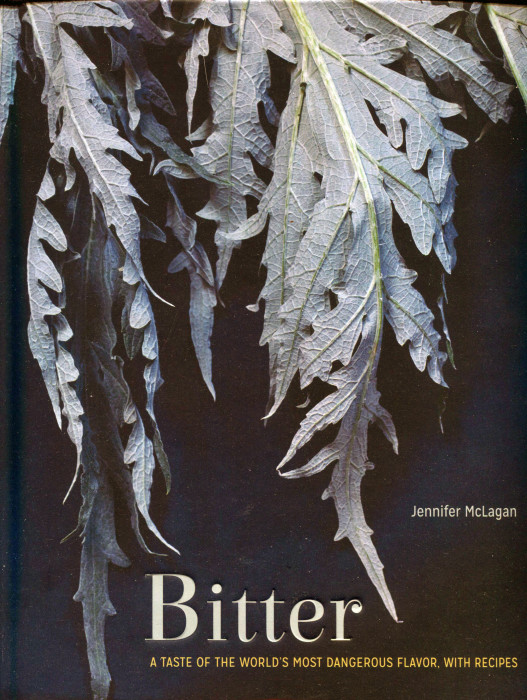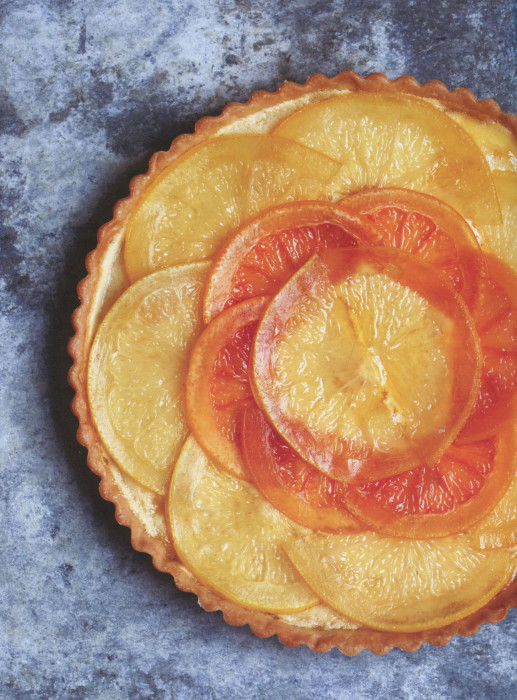Jennifer McLagan is the author of three famous and now a fourth equally wonderful book each focused deeply on one topic. Bitter [2014] follows the tradition of Bones [2005], Fat [2008], and Odd Bits [2011]. That tradition is on of intensity, insight, and scholarship.
Thanks to Fat, I now guiltlessly eat a succulent lamb chop and know that it is really, really good for me. Born in Australia and now living, writing and of course cooking in Canada, Jennifer produces books that are like no other. They will not just educate you but surprise you with insights.
In fact, for Bitter, Jennifer found herself surprised. Here’s a simple question: what is bitter? There is not simple answer. You may be startled to see what foods are generally considered to be bitter:
- Endive
- Broccoli Rape
- Turnips
- Cardoons
- Coffee
- Chocolate
- Arugula
- White Asparagus
- Walnuts Beer
But when she contacted her friends for a “gut check” on what they considered to be bitter, there came an avalanche with some controversy:
- Cucumber
- Celery
- Eggplant
- Lemons
- Pickled Onions
- Rhubarb,
- Seville Orange Marmalade
- Sorrel
- Coffee
Aren’t these last ones just sour? Oh, there’s the problem.
Those taste buds on your tongue can distinguish the 3 S’s and the 1 B: sweet, sour, salty and bitter [I know there’s a list of “other” taste buds but for now ….]. Sweet and salty we all can all recognize. But sour versus bitter is where the nuance begins. Lemon juice is sour. Lemon peel is bitter.
Bitter is filled with discussion about how we taste and smell foods and how this confusion over sour-versus-bitter is one that perhaps can never be resolved. There is science and sociology here in Bitter, and, of course, recipes.
One note. The taste buds in your mouth are replaced every ten days. But as you age, there are fewer of them. The buds that sense “bitter” are actually a collection, different ones devoted to different chemical triggers. It isn’t simple and it changes over time.
Genetically, humans avoid bitter flavor because it often comes from substances that are poisonous. So our instinctive jerk reaction to bitter is one that is programmed deep into our brains. Yet, Jennifer argues, bitter is still a fundamental flavor and should not be eliminated from our kitchens. In fact, bitter is needed to balance sweetness, a job it does better than mere sour. And bitter is needed for completeness in many dishes.
She proves that in chapters of recipes arranged by bitterness type:
Born to Be Bitter features foods like endive and escarole that are indisputably bitter. And, being bitter, may be ones that you shy away from. You might want to give them a second try with recipes like:
Curly Endive with Miso and Chile Dressing
Raw and Cooked Escarole with Garlic and Herbs
Belgian Endive Bathed in Butter
Radicchio and Pumpkin Risotto
Liquid Bitter displays the potency of beer, tea, and coffee:
Beer-Glazed Carrots
Tea Custard with Poached Fruit
Pork Chops in Coffee Black Current Sauce
Tea-Poached Peaches
There many examples in this book of bitter teaming with sweetness to complete a more elevated dish. Elevation is a by-word for any McLagan recipe.
Does bitter appear just as a taste or also as a smell. In Pungently Bitter, you find recipes that depend on the aroma of bitterness:
Brussels Sprouts Salad
Turnip and Fava Bean Stew
Rutabaga Puree with Caramelized Shallots
Horseradish and Avocado Quenelles
That recipe for quenelles is preceded by a wonderful survey of horseradish. Here’s one gem: horseradish has nothing to do with horses; it’s really from “hoarse” meaning harsh or strong. That surely is the quintessence of horseradish.
Subtly Bitter features savory and sweet ideas that extend a touch of bitterness you will undoubtedly enjoy:
Grapefruit Tart
Seville Orange Sabayon
Seville Orange Pork Shoulder
Apricot Tarte Tatin
Here’s something to look forward to: Suzen and I will be making the Grapefruit Tart for it is the one of the most beautiful desserts you could imagine. How beautiful? Here’s a picture:
Surprising Bitter takes you on journeys you may never have considered:
Cardoon Gratin
White Asparagus with Blood Orange Sauce
Celery and Arugula Leaf Salad
Tarragon Roasted Celery
Lastly, Dark, Forbidden, and Very Bitter is a grab bag of ideas, savory and sweet, beginnings and endings:
Chocolate Tart
Lamb with Dark Chocolate Pepper Sauce
Caramel Ice Cream
Tobacco Chocolate Truffles
Bitter Melon with Pork
Bitter is another brilliant work by Jennifer. If you begin to scan the book, you’ll find your pace slowing down. You will, figuratively, stumble for you cannot read “Tarragon Roasted Celery” and not pause to wonder just what that would taste like.
Fortunately, the recipes in Bitter are easy for the home cook. Typically a half dozen ingredients and as many steps. It’s not food in 30 minutes necessarily but it is food that will leave a distinctive taste in your mouth and memories in your brain. Bitter? Yes, perhaps forward and perhaps subtly in the background. Delicious? Oh, so!


